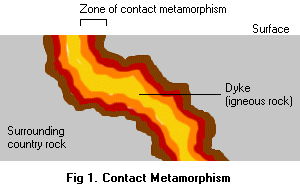 | |||||
| About Us | Contact Us | Services | Copyright | |||||
|
|||||
|
Metamorphic Rocks By Marilyn Fraser
Some rocks that have been altered from sedimentary rocks are slate, mica, schist, gneiss, quartzite and marble. Some altered forms of igneous rocks are actinolite, chlorite, and amphibolite. The Metamorphic ProcessThe difficult name for this class of rocks comes from two Greek words: meta which means "after" and morphe meaning "shape" – a rock which has changed its shape. There are several causes for rocks changing in this way. An increase in temperature and pressure caused by geological movement such as earthquakes or volcanic eruptions can change the rocks. Water carrying chemicals can be the cause of new minerals in the rocks. A very long period of time is necessary for these changes to occur.Completely new minerals can be formed that were not in the original rock or original mineral crystals. Original mineral crystals can be rearranged in shape, though not chemically altered. Water and carbon dioxide are frequently added or removed during metamorphism. Contact MetamorphismThermal or contact metamorphism happens when igneous rocks are intruded or force their way up into the "country rock". Because the igneous rocks are hot (lava or magma) they heat surrounding rock and add pressure. In this way, new minerals are formed and recrystallization takes place. When magma pushes or intrudes this way, it forms what geologists call a dyke or sill. Dykes run vertically through the crust and sills run horizontally forcing their way between layers of the crust rock. A good place to look for metamorphic rocks is along the sides of dykes or sills.
 After the dykes or sills have formed, the Earth's crust can be shifted and upended by earthquakes and other events so that when you see it, it may be standing on end or tilted this way or that, not exactly vertically and horizontally as described in the definition. Regional MetamorphismRegional metamorphism is caused by large movements of the Earth's crust such as mountain building creating great pressure and heat on the rocks forming the crust. The rocks becomes folded over each other, twisted and doubled. These metamorphic rocks often compose large masses of some of the oldest known rocks – up to 3500 million years old.Minerals found in Metamorphic RocksSome minerals that are common to all types of rock are quartz, feldspar and muscovite. Some minerals found only, or mainly in metamorphic rocks are garnet, kyanite, staurolite, cordierite, epidote, and chlorite.Many minerals growing in this type of rock tend to have crystals growing in a particular direction. New minerals grow at right angles to the direction of maximum pressure. These kinds of rocks usually have a certain fabric – a pattern running in one direction. They will likely have cleavage in that direction as well. Rocks such as marbles and quartzite do not develop a visible fabric as a rule. Glossary
Cleavage, rock – a rock will break or split smoothly and each split will be parallel. Crystal – a solid with definite chemical composition and ordered structure with natural plane faces. Felsic – rock with light-coloured silicate minerals such as feldspar and quartz. Gneiss – coarse-grained banded metamorphic rock. Lithology – the laboratory study of rocks. Mafic – rock with dark-coloured silicate minerals such as pyroxene and amphiboles. Petrology – the study of the origin of rocks. Schist – coarse-grained metamorphic rock showing minerals aligned in parallel layers. Ultrabasic or Ultramafic – igneous rocks of dark minerals with no quartz and little feldspar. They have iron minerals.
This article may not be copied, distributed or reprinted in any form without the author's permission. To contact the author, please use the e-mail address provided. If you are unable to contact the author, please contact the Canadian Rockhound. Authorized reprints must acknowledge the author and the Canadian Rockhound, and include the website URL address of the Canadian Rockhound.
|
||

Copyright © 2000 Canadian Rockhound
Magazine Issues |
News & Events |
Junior Rockhound |
Resources
|
||